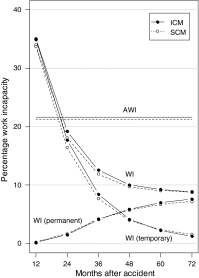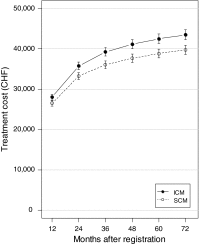Work Incapacity and Treatment Costs After Severe Accidents: Standard Versus Intensive Case Management in a 6-Year Randomized Controlled Trial
- PMID: 26687330
- PMCID: PMC4967427
- DOI: 10.1007/s10926-015-9615-0
Work Incapacity and Treatment Costs After Severe Accidents: Standard Versus Intensive Case Management in a 6-Year Randomized Controlled Trial
Abstract
Purpose Case management is widely accepted as an effective method to support medical rehabilitation and vocational reintegration of accident victims with musculoskeletal injuries. This study investigates whether more intensive case management improves outcomes such as work incapacity and treatment costs for severely injured patients. Methods 8,050 patients were randomly allocated either to standard case management (SCM, administered by claims specialists) or intensive case management (ICM, administered by case managers). These study groups differ mainly by caseload, which was approximately 100 cases in SCM and 35 in ICM. The setting is equivalent to a prospective randomized controlled trial. A 6-year follow-up period was chosen in order to encompass both short-term insurance benefits and permanent disability costs. All data were extracted from administrative insurance databases. Results Average work incapacity over the 6-year follow-up, including contributions from daily allowances and permanent losses from disability, was slightly but insignificantly higher under ICM than under SCM (21.6 vs. 21.3 % of pre-accident work capacity). Remaining work incapacity after 6 years of follow-up showed no difference between ICM and SCM (8.9 vs. 8.8 % of pre-accident work incapacity). Treatment costs were 43,500 Swiss Francs (CHF) in ICM compared to 39,800 in SCM (+9.4 %, p = 0.01). The number of care providers involved in ICM was 10.5 compared to 10.0 in ICM (+5.0 %, p < 0.001). Conclusions Contrary to expectations, ICM did not reduce work incapacity as compared to SCM, but did increase healthcare consumption and treatment costs. It is concluded that the intensity of case management alone is not sufficient to improve rehabilitation and vocational reintegration of accident victims.
Keywords: Accident; Case management; Insurance; Return to work; Treatment costs.
Figures



References
Publication types
MeSH terms
LinkOut - more resources
Full Text Sources
Other Literature Sources

